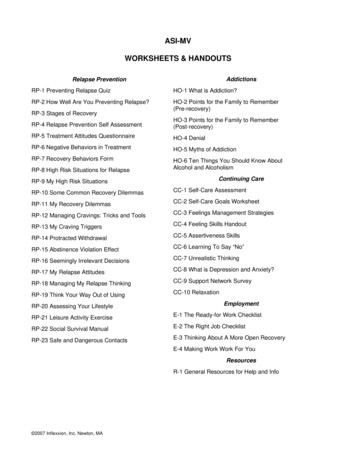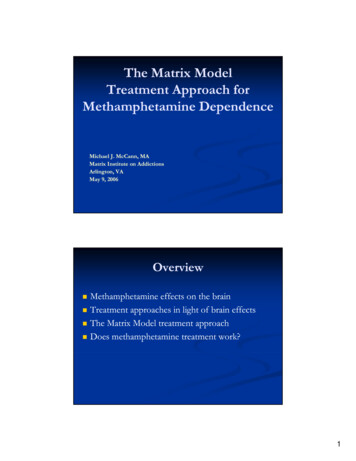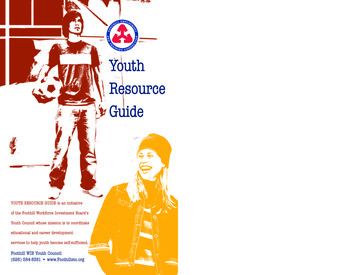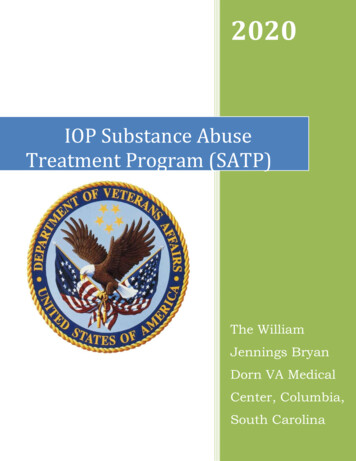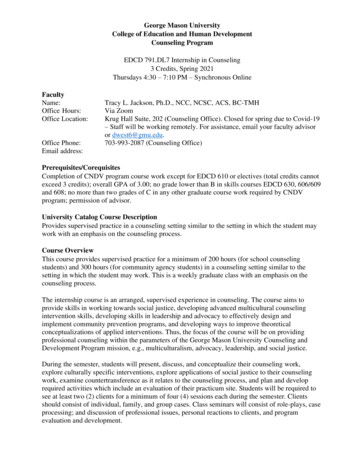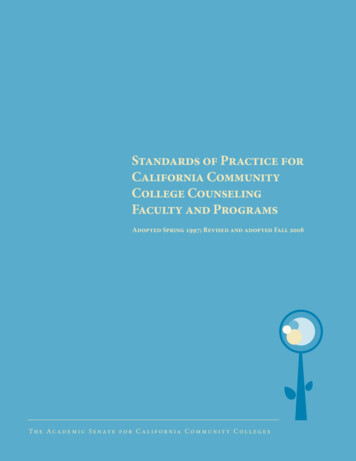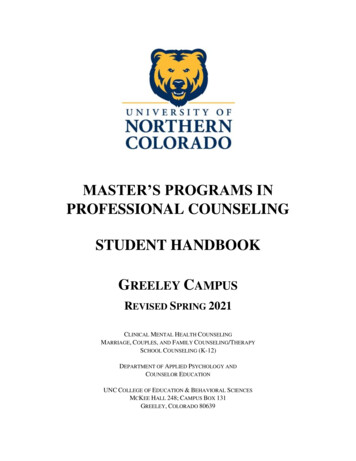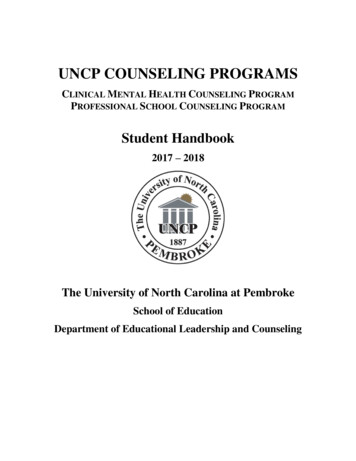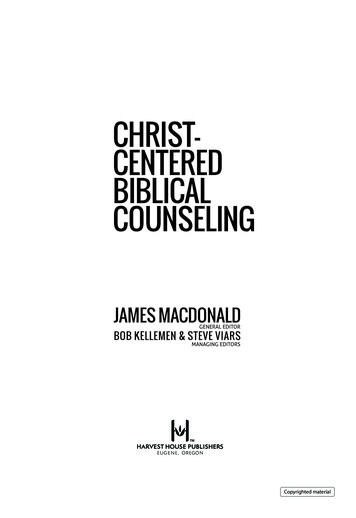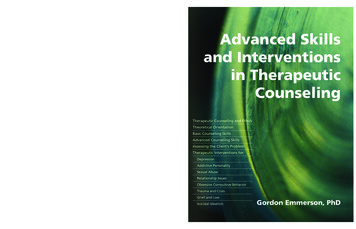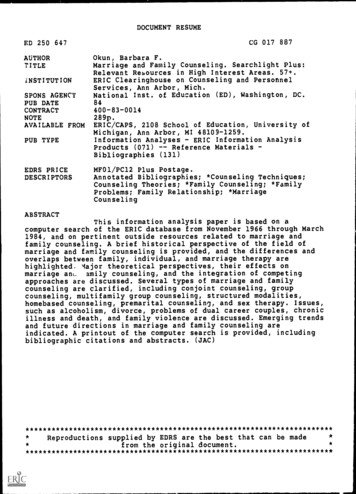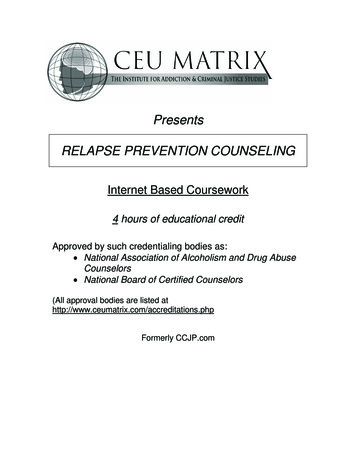
Transcription
PresentsRELAPSE PREVENTION COUNSELINGInternet Based Coursework4 hours of educational creditApproved by such credentialing bodies as: National Association of Alcoholism and Drug AbuseCounselors National Board of Certified Counselors(All approval bodies are listed rly CCJP.com
RELAPSE PREVENTION COUNSELINGWelcome to the growing family of coursework participants at CEU Matrix - TheInstitute for Addiction and Criminal Justice Studies.This distance learning course package was developed for CEU Matrix by DennisC. Daley, PhD. It is based on information found in the manual RelapsePrevention Counseling, Daley Publications.This package contains the course materials, along with the post test andevaluation that are required to obtain the certificate of completion for the course.You may submit your answers online to receive the fastest response and accessto your online certificate of completion. To take advantage of this option, simplyaccess the Student Center at http://www.ceumatrix.com/studentcenter; login as aReturning Customer by entering your email address, password, and click on'Take Exam'. For your convenience, we have also enclosed an answer sheetthat will allow you to submit your answers by mail or by fax.Copyright NoticeThe documents and information on this Web site, excluding the RelapsePrevention Counseling manual, are copyrighted materials of CEUMatrix, LLC,and its information providers. Reproduction or storage of materials retrievedfrom this service is subject to the U.S. Copyright Act of 1976, Title 17 U.S.C. Copyright 2010 CEUMatrix, LLC.All rights reserved. Do not duplicate or redistribute in any form. Printed in theUnited States of America. No portion of this publication may be reproduced inany manner without the written permission of the publisher.
About the Instructor:Dennis C. Daley, Ph.D., is a Professor of Psychiatry, and Chief of AddictionMedicine Services at Western Psychiatric Institute and Clinic (WPIC) of theUniversity of Pittsburgh Medical Center. He oversees a large continuum of careat Addiction Medicine Services (AMS), which includes over twenty-five treatment,prevention and intervention programs, training programs for psychiatric residents,medical students and graduate students in behavioral health.Dr. Daley has been or is currently an investigator, trainer and/or consultant onnumerous research studies at WPIC sponsored by the National Institute on DrugAbuse and National Institute on Alcohol Abuse and Alcoholism related totreatment of individuals with substance use disorders and mood disorders. He iscurrently a trainer and consultant on a NIDA sponsored study of bipolarsubstance abusers at Harvard Medical School (Roger Weiss, MD, PI). Dr. Daleyand colleagues at AMS are currently involved in seven research projects. Hisresearch interests are in the areas of addiction, mood disorders and addiction,and adherence to treatment.Using the Homepage for CEU Matrix - The Institutefor Addiction and Criminal Justice StudiesThe CEUMatrix – The Institute for Addiction and Criminal Justice Studieshomepage (www.ceumatrix.com) contains many pieces of information andvaluable links to a variety of programs, news and research findings, andinformation about credentialing – both local and national. We update our site ona regular basis to keep you apprised of any changes or developments in the fieldof addiction counseling and credentialing. Be sure to visit our site regularly, andwe do recommend that you bookmark the site for fast and easy return.
RELAPSE PREVENTION COUNSELINGThis course is designed to help clinicians and counselors understand andfacilitate the process of recovery among addicted clients and reduce their risk ofrelapse. The primary focus is reviewing clinical strategies to help clients reducerelapse risk or intervene early in the relapse process, and describe clinical toolsthat can be incorporated into individual, group or family sessions. Sources ofinformation for this course are studies of treatment of addiction and relapse,clinical literature, the author's experiences as clinicians and researchers, anddeveloping relapse prevention programs and materials for addicted individualsand families. The source material is also a reference on recovery and relapseprevention.
Treatment Manuals for professionalsRelapse Prevention CounselingStrategies to aidrecovery from addictionand reduce relapse riskDennis C. Daley, PhDAntoine douaihy, md
ISBN: 978-0-9835302-0-6 2011 by Dennis C. Daley, Ph.D.All rights reserved. No part of this book can be reproduced, stored in a retrievalsystem, or transmitted by any means, electronic, mechanical, photocopying,recording, or otherwise, without written permission from the first author.Comments about this book or information about clinical workshops on RelapsePrevention can be sent to the first author at daleypublications@yahoo.com.Daley PublicationsBox 161Murrysville, PA 15668Phone: 724-727-3640Fax:724-325-9515Email: comAuthors’ NoteWe thank Cindy Hurney for her help in reformatting and organizing this book. Wealso wish to thank Janis McDonald for her help with references.
Table of Contents: Relapse Prevention CounselingDedication to G. Alan Marlatt, PhDAbout This Book1.Addiction, Treatment and Recovery.1Purpose of BookCauses of AddictionEffects of AddictionTreatment of AddictionRecovery from Addiction2.Causes and Effects of Relapse. 9Lapse and Relapse DefinedCauses of Relapse in AddictionEffects of Relapse in Addiction3.Relapse Prevention.13Treatment Models Incorporating RP PrinciplesModels of Relapse PreventionLimitations of Studies and Reviews of RPResearch Support for RPConclusions4.Counseling Strategies to Reduce Relapse Risk .25Introduction and Overview of ChapterTreatment AdherenceMedication-Assisted RecoveryAddiction Management SkillsPsychiatric Illness Management SkillsEmotional Management SkillsRelationship Skills and Support SystemsRelapse Recognition and Interruption SkillsLifestyle Changes5.Counseling Aids for Relapse Prevention.47Addict Aftercare Recovery Training and Self-Help ManualChallenging Relapse ThoughtsCognitive Distortions and RelapseConsequences of Using Substances AgainControl-O-LogDaily RP Inventory
Relapse AutobiographyRelapse DebriefingRelapse FantasyRelapse Prevention WorkbookRelapse Prevention Readings (Bibliotherapy)Role Plays (Behavioral Rehearsals)The Road to RelapseSobriety Journal (written)Sobriety Journal (electronic)6.Relapse Prevention Groups.59Creating RP GroupsGroup Format for Outpatient SettingsGroup Format for Residential or Inpatient SettingsOrienting Clients to RP GroupsStrategies for RP Group Leaders in Covering Group ContentCurriculum for 12 Structured RP GroupsTopic #1: The Process and Domains of RecoveryTopic #2: Managing Cravings to Use SubstancesTopic #3: Managing AngerTopic #4: Managing Boredom and Using Leisure TimeTopic #5: Managing Social Pressures to Use SubstancesTopic #6: Establishing a Recovery Support SystemTopic #7: How Mutual Support Programs Help Reduce Relapse RiskTopic #8: Identifying and Managing Relapse Warning SignsTopic #9: Identifying and Managing High Risk Relapse FactorsTopic #10: Managing Setbacks (Stopping a Lapse or Relapse)Topic #11: Building a Long-Term Recovery PlanTopic #12: Lifestyle Balancing7.Problem Solving or Therapy Groups.95Purpose of GroupsObjectives of GroupsGroup FormatProblems Discussed in Problem Solving or Therapy Group SessionsProblems Encountered in the Group ProcessAppendices .1051. Endnotes2. References and Suggested Readings3. Interactive Workbooks and Journals4. Web Sites
Dedication to G. Alan Marlatt, PhDWe dedicate this book to a friend and colleague, Alan Marlatt who recently passed away. Hewas a Professor of Psychology and the Director of the Addictive Behaviors Research Center atthe University of Washington in Seattle. Alan was a pioneer in the field of addiction and the firstto publish a comprehensive review of Relapse Prevention (RP) and focus on the importance ofhelping clients learn skills to manage their addiction, change their lives and take action early ifthey were unable to stay sober. His influence on the fields of addiction and psychology wasenormous. Alan stimulated the addiction treatment field with his forward thinking, his researchand his teaching on numerous topics related to addiction, treatment, recovery and relapse.He was a good friend and mentor to many of us in the U.S. and other countries. Alan was wellrespected for his many contributions to the field, and his book on RP is one of the most highlyreferenced books in the literature. He received many awards for excellence of his workincluding the Jellinek Memorial Award (1990), the Combating Substance Abuse Award by theRobert Wood Johnson Foundation (2001), Distinguished Researcher Award from the ResearchSociety on Alcoholism (2004), and the distinguished scientific Contributions to ClinicalPsychology Award by the American Psychological Association (2009).I (dd) first learned about Alan’s work in the 1980’s when I worked as a therapist in a residentialtreatment program and read a book chapter he wrote on relapse in addiction. His framework forunderstanding the multiple causes of relapse and intervention strategies was impressive. In atime before the age of the internet, I called him to discuss his ideas and what I was doing in thearea of RP in a treatment program. He was receptive to my call, very helpful and respectful andinterested in my clinical work. This led to a long-term relationship. I brought Alan to Pittsburghon numerous occasions to present on RP. We co-presented at several conferences in the U.S.together. We invited each other to co-author articles and books. And, we talked by phone oremail throughout the years to keep up on what each other was doing. In the early years I referredto him as the “grandfather of RP.” I told him his emphasis on RP was a major positive influenceon the field of addiction treatment.Many newspaper (such as NY Times) and magazine articles (such as Time) have been writtenabout Dr. Marlatt to share appreciation for his impact on individuals and his field. His goodfriend and colleague, Dennis Donovan, PhD from the University of Washington (also a friendand colleague of ours) stated that “Alan has been a mentor, friend, and colleague to many of ushere at UW, and his network of associates and those whom he has touched personally andprofessionally is extensive and international in scope. We have lost a true visionary andluminary in the field of addictions. He will leave his prints in our hearts and minds, and there isa cadre of us to carry on the important work that he has championed throughout his career.”Another colleague, Dr. Fred Rotgers, the President of the Society on Addiction Psychology said“It is. . .impossible to recount briefly how much Alan has meant to the field of addictionpsychology, to addictions treatment and research. . .Alan also had a direct impact on many of usthrough his friendship, mentorship and genuine humanity.”
About this BookThis book was written to help clinicians in programs that provide treatment of substance usedisorders (addiction medicine and mental health programs) understand and address the problemof relapse. It is written in a brief, succinct manner to summarize strategies to facilitate recoveryfrom addiction and reduce relapse risk. It can be used by clinicians to incorporate relapseprevention strategies into treatment. This book is also a reference on recovery and relapseprevention (see endnotes, references and suggested readings, recovery materials, and webresources).About the AuthorsDennis C. Daley, Ph.D. is Professor of Psychiatry and Chief of Addiction Medicine Services(AMS) at Western Psychiatric Institute and Clinic (WPIC) of the University of PittsburghMedical Center. Dr. Daley has provided services to individuals with addiction for over 30 years.He was one of the first in the U.S. to write interactive recovery materials for clients and authoredthe Relapse Prevention Workbook used throughout the U.S. and other countries. Dr. Daley alsoauthored a recovery video Staying Sober, Keeping Straight and a series of 19 interactive videos(Living Sober I, II, and III) aimed at facilitating recovery and reducing relapse risk. He aresearcher, consultant and trainer on many studies funded by the National Institute on DrugAbuse and the National Institute on Alcohol Abuse and Alcoholism. Dr. Daley has over 260publications on recovery from addiction or co-occurring disorders. His materials are usedthroughout the U.S. and several have been translated to foreign languages. He contributed to theSAMHSA Treatment Improvement Protocol on Relapse Prevention that is currently being written.Antoine Douaihy, M.D. is Associate Professor of Psychiatry, Medical Director of AMS and severalclinical programs as well as an HIV clinic. Dr. Douaihy is involved in providing clinical services,teaching and research. He has many publications for professionals and individuals in recoveryincluding recovery journals and workbooks. Both Drs. Douaihy and Dr. Daley have workedtogether for many years in clinical programs, research, teaching and writing projects. They havebeen involved in several funded studies on the treatment of addiction.About Daley PublicationsWe offer books and manuals for clinicians on treatment of addiction and co-occurring disorders.We also offer materials for clients and families in recovery such as workbooks and journals.These materials are brief, informative, user-friendly and useful for individuals with substance usedisorders, psychiatric illness, and/or co-occurring disorders (psychiatric and substance usedisorders combined). These materials can be used in addiction medicine, mental healthprograms and co-occurring disorders programs. Descriptions of materials are available on thewebpage: www.drdenniscdaley.com.
CHAPTER ONEAddiction and RecoveryPurpose of BookProblems with the use of alcohol, nicotine, illicit drugs (heroin, cocaine, cannabis and others)and prescription drugs (for pain, anxiety and other conditions) affect millions of people in theUnited States. One major community study found over 16% of adults in our country experienceda substance use disorder (referred to as addiction in this book) at some point during theirlifetimes with alcohol being the most common substance problem.1 Many of these individualshave problems with more than one substance.Addicted individuals are at increased risk for medical, psychological, family, legal, occupational,economic and spiritual problems.2 Their families experience an emotional and financial burden.Society is adversely affected as addiction costs hundreds of billions of dollars in lost wages andproductivity, and the cost of medical care, criminal justice and other services needed as a resultof consequences of addiction such as accidents, medical disorders, psychiatric problems, loss ofjobs and criminal behaviors.On a positive and hopeful note, involvement in professional treatment and mutual supportprograms such as Alcoholics Anonymous (AA), Narcotics Anonymous (NA), other 12-Stepprograms and other mutual support programs helps many of these individuals learn to managetheir addiction by engaging in recovery and learning coping strategies to reduce their risk ofrelapse.3 A major goal of treatment or involvement in recovery support groups is to preventrelapse or reduce relapse risk. A goal for families is to help them understand addiction, recoveryand relapse and how they can help their loved one and themselves. Another goal is to learn howto intervene quickly in the process of a lapse or relapse to limit the damage.The purpose of this book is to help clinicians understand and facilitate the process of recoveryamong addicted clients and reduce their risk of relapse. The primary focus is reviewing clinicalstrategies to help clients reduce relapse risk or intervene early in the relapse process, anddescribe clinical tools that can be incorporated into individual, group or family sessions. Sourcesof information for this book are studies of treatment of addiction and relapse, clinical literature,and the authors’ experiences and as clinicians and researchers, and developing relapse prevention(RP) programs and materials for addicted individuals and families.We recently conducted a training needs survey of a large group of clinicians who provide treatmentin numerous residential and ambulatory addiction medicine programs. Results showed that a majorarea of clinical interest was RP. Another result was that clinicians do not read a lot, perhapsbecause they are busy with work and personal lives. Therefore, this book (an update from a1
previous version) was reduced in length to make it more manageable for busy clinicians to read anduse in their clinical practice.This first chapter provides a brief review of addiction, treatment and recovery. It does not providethe symptoms of addiction or other substance use disorders and assumes the reader is familiar withthe categories of substance use disorders and symptoms of addiction (dependence).3Chapter two provides definitions of lapse and relapse as they relate to addiction. The multiplefactors contributing to relapse and effects of relapse are then discussed.The third chapter provides an overview of relapse prevention, treatment models that incorporate RPprinciples, specific models of RP and research support for RP. Readers interested in more in depthreview of the RP literature or specific models can consult the references at the end of this book.Chapter four discusses counseling strategies to aid recovery and reduce relapse risk. These areorganized in the following categories, each with specific examples:1. Treatment adherence2. Medication-assisted recovery3. Addiction management skills4. Psychiatric management skills (since many clients have co-occurring mental healthproblems)5. Emotion management skills6. Relationship skills and support systems7. Cognitive coping skills8. Relapse recognition and interruption skills9. Lifestyle changesThe reader will note the term “skills” used throughout as clients need to learn coping strategies orskills to manage their addiction and engage in a recovery process.The fifth chapter provides a summary of counseling tools. These can be used to help individuals,groups or family members. They can be incorporated into any type of addiction treatment program(detoxification, residential, ambulatory, narcotic addiction or specialty programs) or mental healthprogram that focuses on co-occurring disorders.Chapter six provides an overview of relapse prevention groups. It gives details on creating RPgroups, formats to use in residential, inpatient and outpatient settings, orienting clients to group andstrategies for leaders to use in conducting these groups. This chapter also provides a curriculum on12 RP group topics that can make up a “core” program for clients.Chapter seven discusses process therapy or problem solving groups that can focus on a broad rangeof issues pertinent to ongoing recovery and relapse prevention. This chapter covers the purposes ofthese groups, objectives and format. It also addresses the problems commonly seen in these types ofgroups as well as problems encountered in the group process.2
An appendix provides references, information about interactive workbooks and journals for clients,and web resources that may be of interest to clinicians, clients and families. The reference sectionprovides an extensive bibliography with a listing of books, papers, studies and recovery guides. Theinteractive workbook appendix provides brief descriptions of recovery materials that facilitaterecovery and reduce relapse risk. Finally, a list of Web Sites provides the reader with additionalresources where information on recovery and relapse can be found.Causes of AddictionAddiction is a multifaceted illness or disease involving physiological, psychological, and socialor cultural factors.4 It is usually a combination of factors rather than just one that leads to anaddiction or the continuation of it, and for many it is a chronic disease. 51. Physiological: similar to other medical illnesses or psychiatric disorders, addiction runsin families. This means that first degree relatives (children or siblings) are at increasedrisk for addiction. One of the most potent predictors of addiction for a son or daughter ishaving a parent with an addiction. The genetic contribution to substance use disorders iscomplex and involves multiple physiological pathways. Genetic factors are important indetermining vulnerability to addiction, but they are not deterministic. Personal andenvironmental factors play an equally important role. There are also differences in brainchemistry or metabolism of addicted individuals that may distinguish them fromnon-addicted persons. For example, many individuals with alcoholism develop a hightolerance for alcohol. They can drink larger quantities than others. Even though theseindividuals drink a lot, they often do not feel high or intoxicated until they haveconsumed large quantities of alcohol. Whereas social drinkers can read body cues thatthey have had enough to drink (or too much), alcoholics usually cannot.2. Psychological: these include personality style, psychological defenses and copingmechanisms. Some people have a personality characterized by “risk taking” or “living onthe edge.” These individuals often (though not always) have a tendency to develop anaddiction. Defense mechanisms are psychological processes to protect people fromsomething that causes anxiety. A common defense used by individuals during their activeaddiction is denial. Denial allows the addicted person to explain away, refuse to believe,or refuse to acknowledge the addiction. How a person handles problems or stresses inlife can determine whether or not substances are relied upon to reduce stress, escapeproblems, or cover up upsetting or difficult feelings such as anger, anxiety, boredom,depression, emptiness, loneliness or guilt. Many people with addiction report thatalcohol or other drugs allow a temporary escape from things in life that are unpleasant.Others have co-existing psychiatric disorders that contribute to their addiction orcomplicate their recovery.63. Social or Cultural: these include influences of the family and ethnic group to which theperson belongs, friends, religious practices and the type of community lived in. Friendsand siblings influence behaviors, including the use of substances. Norms are the “rules”of a culture or subculture and refer to beliefs that guide an individual’s behavior. If a3
particular group reinforces getting high or deviant behaviors related to substance use, theindividual may be more prone to using substance and eventually becoming addicted.The features of addiction contributing to its onset and early development may have no bearing ontoday's manifestation of the illness. How or why a person became dependent may be completelyunrelated to how or why the addiction continues. Once addicted, no reason is needed for it tocontinue as it takes on a life of its own. That is, addicted people continue to use alcohol or otherdrugs regardless of the consequences.Effects of AddictionThe effects of addiction vary and are not confined to just the person with the addiction. Others,especially the family, are also affected.7 Some of these effects are obvious while others aresubtle and hidden. The effects of addiction are determined by the amount and frequency of alcohol or drug use, how the drug is ingested (i.e., smoking, using needles), age, gender, diet, healthand behaviors of the person. The co-existence of serious medical or psychiatric disorders alsohelps to determine the effects of addiction.Addiction can produce new or aggravate existing problems in any area of life. The effects rangefrom mild to fatal. Hundreds of thousands of people die every year from the direct and indirecteffects of alcohol and drug use, including nicotine.Following is a brief summary of problems caused or worsened by an addiction:81. Medical or Health Problems: accidents, injuries, overdoses, or diseases can be caused orworsened by substance use disorders. Sometimes, pre-existing illnesses are aggravated.Among women, addiction is associated with complications with the menstrual cycle,pregnancy and childbirth. Drug abusers who use or share needles and equipment withothers increase their risk for hepatitis B and C, and HIV/AIDS. Death or seriousdisability may occur due to vehicular accidents, falls, violence, drug or alcohol overdosesor suicide attempts.2. Psychological Problems and Psychiatric Disorders: addiction affects thinking, emotions,and behaviors. It contributes to psychological or mental health problems such as lowself-esteem, aggressive or impulsive behavior, homicidality, suicidality and thedevelopment of poor coping mechanisms. In many instances, a co-occurring psychiatricdisorder is present, which complicates recovery from addiction. Two majorepidemiologic studies conducted in the community and numerous studies conductedamong individuals in treatment show that that many individuals have both an addictionand co-occurring psychiatric disorder.Individuals with co-occurring disorders often have more problems than those with singledisorders.9 These include financial problems, unstable housing and homelessness,violence, legal problems, incarceration, depression, suicide, family problems, sexuallytransmitted diseases and HIV transmission or acquisition. The co-occurrence of mentalhealth and substance use disorders worsens the course of both illnesses and compromisestreatment response compared to either disorder alone. Individuals with co-occurring4
disorders are also more likely to be non-compliant with medications or appointments withtheir psychiatrist, fail to show for therapy sessions or day treatment programs, drop out oftreatment early, fail to transition successfully from inpatient to outpatient treatment, andto be hospitalized multiple times.3. Family Problems: compared to families with no addiction, those in which this problemexists have higher breakup rates from separation or divorce. The family atmosphere isoften permeated by worry, fear or conflict. The rates of child abuse or incidents ofdomestic violence are higher. Violence should be a major concern in treatment andprevention. Other family problems are poor communication and failure of parents towork together as a team. In addition to adverse effects of addiction on the family unit ormarriage, individual family members, including children, are also hurt by addiction.These effects include depression, chronic anxiety or worry, feelings of guilt and shame,and substance abuse. Children in these families are at higher risk for developing anaddiction themselves. Compared to children in families where there is no addiction,children in addicted families are also more likely to have psychiatric disorders(depression, anxiety, attention deficit disorder, conduct disorder), aggressive behaviors,greater impulsivity, problems with inattention or irritability, lower IQ scores and poorschool performance.10 Families and others close to the addicted individual maycontribute to the development and maintenance of substance use. They also play a role inhelping the addicted individual to recognize a problem and seek help.4. Social and Legal Problems: addiction harms relationships with family, friends andcolleagues. Addicted individuals cause conflicts in, or lose love relationships as a resultof their behaviors or the problems created or worsened by their addiction. They are morelikely to get involved the criminal justice system because of drunken driving, violence,theft, homicide or other crimes. Jails and prisons are full of people whose criminalbehaviors were influenced by their addiction. Impaired judgment due to the effects of asubstance could cause a person to engage in a criminal behavior. Or, criminal behaviorcould result from the need to get money to pay for an expensive addiction.5. Job Problems: these include absenteeism or being a less productive, efficient andresponsible worker. Accidents on the job are more common when the person is impairedby substances. Others lose motivation to find work when unemployed. Others aresuspended or fired due to poor performance, which often is caused by the effects ofaddiction.6. Spiritual Problems: some abandon their spiritual beliefs or practices as addictionprogresses. They may feel "lost," "empty," or that life is "meaningless." Feeling guiltyand ashamed is common. One client described his experience as follows: “I becamespiritually bankrupt. My values changed and I did things I never would have done if Iwasn’t addicted. I shamed my family and myself. I lost interest in religion and Church.5
Treatment of AddictionThere are many evidence-based treatments (EBTs) or practices (EBPs) for addiction. Theseinclude behavioral treatments,11 medication-assisted treatments12 and combined treatments.13Treatment helps addicted individuals engage in treatment, reduce or stop substance use and makepositive changes in themselves or their lifestyles. Treatment may contribute to improvements inany domain of functioning: health, psychological, family, so
the Relapse Prevention Workbook used throughout the U.S. and other countries. Dr. Daley also authored a recovery video Staying Sober, Keeping Straight and a series of 19 interactive videos (Living Sober I, II, and III) aimed at facilitating
